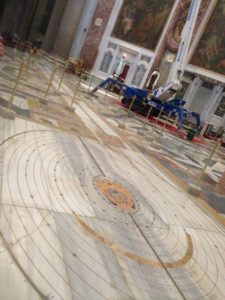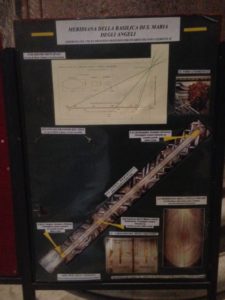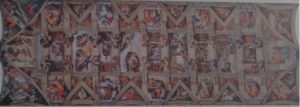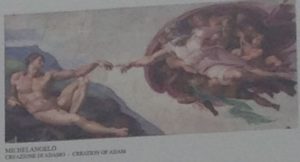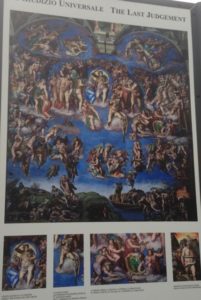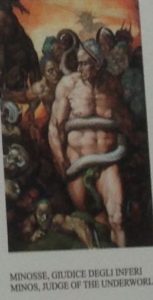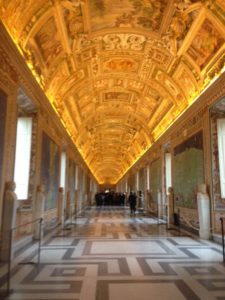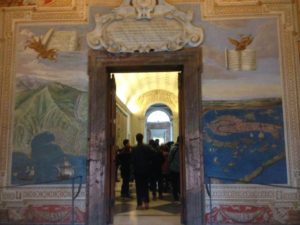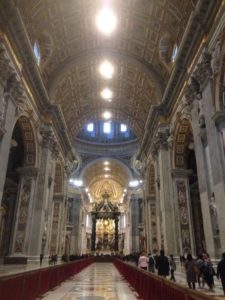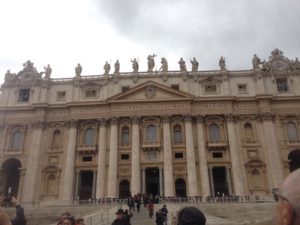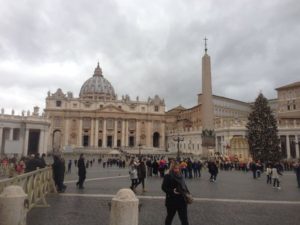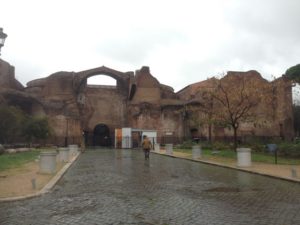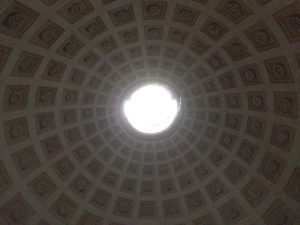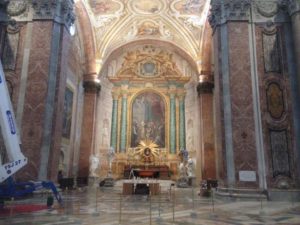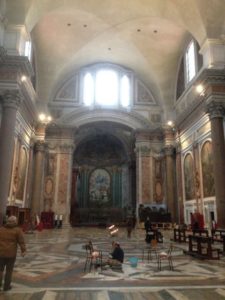Today we headed out early for a walking tour of the Vatican arranged by Gate 1. Our guide met us outside the Vatican Museum and we were able to skip the lines and go directly into the garden where our guide gave us information on the Vatican, which is an independent state established in 1860’s when Italy was unified by Garibaldi. Before that, the Pope was king of Rome, but after unification, the Pope withdrew to the Vatican on right bank of the Tiber outside the city. In 1929 Mussollini recognized it as an independent state.
When the Sistine Chapel was built in 1476, painting masters came from Florence to paint the frescoes on the side walls. In 1508, the new pope asked Michelangelo to come to Rome to sculpt his funeral monument but changed his mind and asked him to paint the ceiling of the Sistine Chapel. Michelangelo refused because he was a sculptor not a painter but nine months later he was persuaded to return and painted the ceiling frescoes in 4 years. The frescoes depict the Creation in nine panels. Because no photos are allowed inside the chapel, I took photos of the panels in the garden.
In the panel depicting the creation of man, notice that God appears inside the shape of a brain.
Thirty years later, another Pope asked Michelangelo (at the age of 62) to paint the Last Judgement on the wall over the altar.
Just before the unveiling, the highest Cardinal objected to the figures being naked. As a result, Michelangelo painted him in hell with a serpent biting his genitals. When the Cardinal objected to the Pope, the Pope said he had no jurisdiction in hell and the Cardinal would have to live with where Michelangelo put him.
Twenty five years later, yet another Pope hired a student of Michelangelo to cover the genitals of the figures.
The map room has frescoes of the geography of Italy which are geographically accurate even though they were done at the end of the 1400’s.
Afterwards, we visited St. Peter’s Basilica, which is the largest church in the world (the length of two football fields). The first church was built on the spot where Saint Peter was martyred under Emperor Nero. The current basilica was built in 1503.
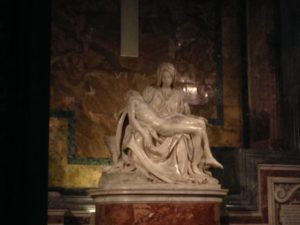 La Pieta was done in 1499 when Michelangelo was 24 years old. He depicts Mary as a young girl holding her adult son as if she were rocking a baby to symbolize eternal motherhood.
La Pieta was done in 1499 when Michelangelo was 24 years old. He depicts Mary as a young girl holding her adult son as if she were rocking a baby to symbolize eternal motherhood.
The bronze canopy over the altar was done by Bernini (the great artist of the 1600’s) from bronze taken from the roof of the Pantheon.
We exited through the main entrance to the Basilica where the Pope delivers his Sunday blessing.
After we left the Vatican, we wandered across the river toward Piazza Navona and had a delicious pasta and wine lunch on a tiny side street. 
We then wandered toward Piazza Navona, where there are three fountains, the central one designed by Michelangelo with one of many obelisks taken from Egypt.
On our way we came across this unnamed ruin in the Piazza de Pietri. 
Then the Pantheon, the oldest Roman temple in Rome.
I was surprised at how close most of the sights are. The Trevi Fountain was five minutes further.
After that we managed to get spectacularly lost, ending up at the Monumento Vittorio Emanuele when we thought we were at the Piazza della Republica. We must have walked ten miles today.
On our second day in Rome, it rained all day. We ventured out at midday to find a restaurant I had looked up before I left, Amadeo, near Termini. Our shoes and the bottom of our pants were wet by the time we got there in spite of umbrellas and jackets, but we had a long, lovely lunch of Ozzo Bucco, truffle pasta, and a bottle of wine. Afterwards, we visited the Basilica de Santa Maria Degli Angeli, built inside one of the domes of the Baths of Diocletian, the largest bath in the Roman world. Michelangelo designed the basilica.
The basilica is immense, which makes you realize how large the baths must have been. The first room has a dome like the Pantheon but with a stained glass covering the opening.
One of the things the basilica is known for is the Meridian clock added by the Pope in the mid 1800’s (because Bologna had one). This one was said to be more accurate. The rays of the sun fall through a tiny hole in the ceiling and trace the time of day on the inlaid marble clock on the floor.
The giant cherry-picker seen in the photo was being used for restoration on the ceiling.